In the early hours of December 14, 1909, a thin blanket of snow laced over the fencing, lampposts, sidewalks and buildings surrounding the Grand Opera House in downtown Peoria, Illinois. On that morning 110 years ago, one of the most beautiful and elaborate buildings in the city’s history burned down to its shell in a catastrophic fire, most likely started by a stray cigarette butt in a rubbish bin.
“The fire was first noticed by Turnkey Frank W. Lichtweiss in the county jail adjoining the theater in the 300 block of Hamilton Street,” reported the Peoria Journal newspaper. The smoke seeped into the jail, causing the inmates to yell out in fright and clank the bars of their cells. Although Peoria’s firefighters fought valiantly, their efforts were fruitless against the mighty blaze. A crowd gathered to watch the destruction of their city’s premier theater, which had been a center of high society and the arts in downtown Peoria for over 27 years. The building was a loss, with damages estimated at $200,000.
Built for Entertainment
The Grand Opera House was the vision of Eugene Baldwin, founder and editor of the Peoria Journal. As its chief promoter and fundraiser, Baldwin collaborated with many movers and shakers in Peoria’s business and social circles to raise the funds to build the grand structure. The land was purchased and the building built at a cost of $72,000. It opened to the public on September 7, 1882.
By this time, theater was already a huge part of Peoria’s culture. In the early days, the city hosted local talent in churches, retail shops and warehouses—and then came the halls. Austin’s Hall, built in 1853, was located at Adams and Fulton streets and could seat 500. Rouse’s Opera Hall at Main and Jefferson could seat 1,200. There was also Haskell’s Hall, Schwab’s Hall, Green’s Hall, the Germania Hall and many others. Peoria had bands and shows of all kinds, as well as music schools, dance schools, glee clubs and theater companies to fill these spaces. But with audiences hungry for live entertainment—including traveling professional performers—the city needed something bigger and better.
At the commencement of this Golden Age of Theater, Eugene Baldwin’s vision became reality with the completion of the Grand Opera House, considered to be one of the most beautiful theaters in the country—and, some claimed, the world. Contractor John H. Flinn was chosen to oversee construction, and he saw the work through to completion. The three-story hall was built with pressed red St. Louis brick and seated 1,744, including multiple levels and eight premier box sections, four on each side. Dividers between the box seats allowed patrons to open up their section for friends who wanted to socialize together during performances.
The front of the theater featured a pair of large, wooden double doors, an office for the theater manager, and two ticket office windows. To the right and left of the entryway were office suites rented to other businesses. There were dressing rooms on the third floor, and the basement housed a massive coal-fired steam generator that heated the entire building. The stage was 44 feet deep, 72 feet wide and 58 feet tall, with two additional dressing rooms at stage right and left.
The theater’s interior was exquisite and full of modern elements such as burgundy-colored carpets, red velvet curtains, and a new color called Bessemer blue, trendy amongst the elite. Real peacock feathers adorned the ceiling fans and elegant swallows were placed smartly along the walls, with accents of Japanese silver and gold pheasants. A large crystal chandelier hung in the center of the auditorium. Gorgeous vases with trailing ivy plants were perfectly placed to and fro, with arabesques enhancing this glorious décor.

A Legacy of Performers
The Grand Opera House opened on September 7, 1882, with the production of A King For A Day featuring Peoria’s own Emma Abbott. Having appeared years earlier at Rouse’s Hall to a less-than-full audience, the world-famous opera singer vowed to return to Peoria and have all of the city pay top billing to hear her sing. These words rang true, and her share of the money from ticket sales was $5,700—a huge sum in those days.
The streets were lined with horse-drawn carriages. Patrons could purchase opera glasses and other accessories; some of the seats even had chocolate dispensing machines attached to their backs. Tobacco, however, was not allowed. The elegant women in attendance were encouraged politely to please remove their large and beautiful hats for the viewing enjoyment of everyone—and the theater was continually booked for the next 27 years, hosting some 250 shows annually.
The great success of the Grand Opera House led to the building of the National Hotel and Bar next door, where gentlemen would go to partake in a drink during intermission. A buzzer was pressed when the show was about to resume, and the men would quickly finish their drinks and rush back to the theater—most of them, anyway.
Many famous actors, singers, speakers and other performers took the stage at the Grand Opera House. Actor Edwin Booth, brother of John Wilkes Booth, performed in the show Rip Van Winkle, for example. When he professed an apology for his brother’s devious actions against President Abraham Lincoln, he was loudly applauded by the audience. Other notables included Maurice Barrymore, patriarch of the family of actors, and George M. Cohan, composer of “Over There” and “You’re a Grand Old Flag,” among other standards, who performed The Yankee Prince to sold-out crowds.
In September of 1882, William “Buffalo Bill” Cody performed in the Western thriller, Twenty Days or Buffalo Bill’s Pledge, dazzling the audience with scout shots at targets from more than 20 different stage positions. Heavyweight champion boxer Bob Fitzsimmons performed at the Opera House in a melodrama called A Fight For Love, portraying a reluctant hero forced to fight for his true love. “Gentleman” Jim Corbett, another heavyweight prize fighter, lent his acting talent to a production called The Adventurer. The great Italian actor Tommaso Salvini starred in the title role of Othello in 1886. The famed Franz Rainer’s Tyrolean Alpine Singers performed at the Grand Opera House in 1890.
On October 24, 1892, the renowned Chicago lawyer Clarence Darrow spoke to a crowd there, rallying for Republican presidential candidate William McKinley. On September 4, 1895, Colonel Robert G. Ingersoll, one of the greatest orators of the day and formerly a prominent lawyer in Peoria, received glowing reviews for his lecture about President Lincoln. Other famous names included Julia Marlowe, Maude Adams, Mary Anderson, Lillian Russell… and the list goes on. Operas, lectures, dramas, comedies, tragedies, magic shows, dancing troupes and other entertainment of all kinds took place in this grandest of all Peoria halls before its devastating finale.
When the flames were finally extinguished, a shattered shell of broken-edged brick walls was all that was left of Peoria’s Grand Opera House—until 1916, when a man named Frank Ryals bought the remains and turned it into a parking lot. Though fire destroyed this grand old building, the energy of these famous (and not-so-famous) performers lives on—a reminder of Peoria’s loftiest heights in the Golden Age of Theater. PM




